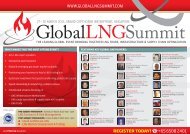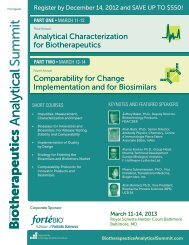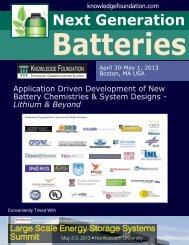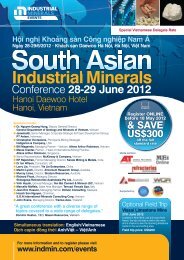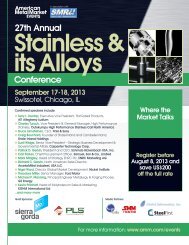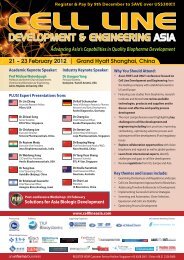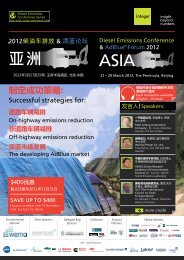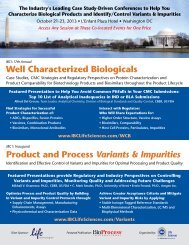HigH-Content AnAlysis
HigH-Content AnAlysis
HigH-Content AnAlysis
You also want an ePaper? Increase the reach of your titles
YUMPU automatically turns print PDFs into web optimized ePapers that Google loves.
Cambridge Healthtech<br />
Institute’s TENTH Annual<br />
January 8-11, 2013<br />
High-<strong>Content</strong><br />
Analysis<br />
Anniversary<br />
3:15-4:15 Refreshment Break in the Sponsored by<br />
Exhibit Hall with Poster Viewing<br />
Novel Biosensor Assays for Screening<br />
4:15-4:40 Development, Optimization and Validation of an<br />
HCS Biosensor Assay to Identify Compounds that Disrupt<br />
AR-TIF2 Protein-Protein Interactions<br />
Paul A. Johnston, Ph.D., Research Associate Professor, Pharmaceutical<br />
Sciences, School of Pharmacy, University of Pittsburgh<br />
High Transcriptional Initiation Factor 2 (TIF2) coactivator expression levels are<br />
associated with prostate cancer (CaP) recurrence after androgen ablation<br />
therapy (AAT). We will describe the development and optimization of a novel<br />
high-content image-based AR-TIF2 protein-protein interaction biosensor<br />
(PPIB) assay that exploits features of protein targeting to organelles, AR and<br />
TIF2 functional domains, and fluorescent reporters to generate positional<br />
biosensors to measure and quantify the interactions between AR and TIF2<br />
in cells. We will validate the performance of the AR-TIF2 PPI HCS assay by<br />
screening the LOPAC and NIH Clinical Collection compound libraries in two<br />
distinct formats; to identify compounds that can either block the formation<br />
or that can disrupt established AR-TIF2 PPI complexes.<br />
4:40-5:05 Novel Approaches to High-<strong>Content</strong> Imaging of<br />
Insulin Receptor Trafficking, Insulin Signaling and Endosomal<br />
Calcium Signaling<br />
James Johnson, Ph.D., Associate Professor, Cellular and Physiological<br />
Sciences, University of British Columbia<br />
We have generated insulin receptor reporters that do not impair<br />
signaling function in cells and will present data on insulin receptor<br />
trafficking and signaling in pancreatic beta-cells. We have developed the<br />
first calcium biosensor capable of measuring calcium in the lumen on<br />
the endosome and will present our analysis of the role for endosomes<br />
as dynamic calcium buffers. We present multiplexing approaches to<br />
generating rich data sets reporting on insulin signaling.<br />
5:05-5:30 High-<strong>Content</strong> Screening for Small Molecule<br />
Inhibitors of HIV Nef<br />
Andreas Vogt, Ph.D., Associate Professor, Drug Discovery Institute,<br />
University of Pittsburgh<br />
The HIV-1 accessory protein Nef is essential for high-titer viral replication<br />
and AIDS progression. The cellular activities of Nef are critically dependent<br />
on a variety of protein-protein interactions, including formation of Nef<br />
oligomers. Nef mutations that interfere with oligomerization prevent HIV<br />
replication in cell culture, suggesting that the Nef oligomerization interface<br />
is a rational target for Nef-directed anti-HIV therapy. In this talk, I will<br />
present the development and validation of a high-content, bimolecular<br />
fluorescence complementation assay for Nef dimerization inhibitors.<br />
HCS at NCATS<br />
5:30-5:55 Supporting Drug Discovery and Reposition in<br />
NCATS Using HCS Technology<br />
Zhuyin (Julie) Li, Ph.D., Biology Team Leader, Division of Pre-Clinical<br />
Innovation, National Center for Advancing Translational Sciences, NIH<br />
The mission of the newly created National Center for Advancing<br />
Translational Sciences (NCATS) in NIH is to catalyze the generation of<br />
innovation methods and technologies that will enhance the development,<br />
testing, and implementation of diagnostics and therapeutics across a wide<br />
range of human diseases and conditions. This presentation will highlight<br />
successful applications of HCS in target validation, compound screening,<br />
MOA study, toxicity investigation and drug repositions in NCATS.<br />
High-<strong>Content</strong> Image and Data Analysis (continued)<br />
4:15-4:40 Using New Cell Dyes and Automated Image<br />
Processing to Evaluate Cellular Responses to Small Molecules<br />
David W. Andrews, Ph.D., Director and Senior Scientist, Biological<br />
Sciences, Sunnybrook Research Institute, Toronto; Professor,<br />
Biochemistry, University of Toronto<br />
Here we describe a simple approach to quantify the responses in<br />
adherent cells to small molecules based on multivariate analysis of<br />
cells stained with new mix and read dyes. These dyes are non-toxic,<br />
non-fluorescent in water and available in several emission/excitation<br />
wavelengths compatible with existing HCA instruments. We compare<br />
multivariate analysis and clustering with more traditional measures<br />
of analysis and find that it provides high Z’ sensitivity and specificity<br />
resulting in improved classification in screening.<br />
4:40-5:05 A Label-Free Random Cell Motility Assay Based<br />
on Image Correlation Spectroscopy<br />
Michael Prummer, Ph.D., Scientist, High-<strong>Content</strong> Screening,<br />
F. Hoffmann-La Roche AG<br />
Cell migration is central to embryonic development, wound healing,<br />
inflammation, and cancer. Sparse metastatic cells or T-cells show<br />
isotropic and random motion, which is difficult to characterize<br />
with classical tools like scratch assays. We use image correlation<br />
spectroscopy (ICS) to quantify the speed and mode of random cell<br />
motility without labeling, identification or trajectory reconstruction. ICS<br />
offers a toolbox to analyze free, directed, hindered, or confined random<br />
walks. The random motility (RAMOT) assay is validated using THP1<br />
immune cells, cytoskeleton modulators and Monte-Carlo simulations.<br />
Combining ICS and HCS, the RAMOT assay opens up new routes in<br />
label-free image-based drug discovery.<br />
5:05-5:30 Image Analysis and Modeling of<br />
Cardiomyocyte Hypertrophy<br />
Jeffrey Saucerman, Ph.D., Assistant Professor, Biomedical<br />
Engineering, University of Virginia<br />
Cardiomyocyte hypertrophy plays a key role in the transition to<br />
heart failure. We are developing automated microscopy and image<br />
analyses to quantify the hypertrophy dynamics of individual live<br />
primary cardiomyocytes. I will present two applications. In the first,<br />
we characterized the kinetics of myocyte hypertrophy in response to<br />
transient receptor agonists. In the second example we used automated<br />
imaging to validate model predictions about the quantitative role of 11<br />
parallel hypertrophy pathways.<br />
5:30-5:55 An Evolving View of Cancer: High-<strong>Content</strong><br />
Analysis and Mathematical Modeling to Study Cancer Cell<br />
Heterogeneity and Resistance<br />
Arijit Chakravarty, Ph.D., Senior Scientist, Modeling and Simulation,<br />
DMPK, Millenium Pharmaceuticals<br />
The changing picture of the landscape of carcinogenesis and tumor<br />
response to therapy frames cancer as a disease of genomic instability<br />
and somatic Darwinian evolution. Developing realistic model systems<br />
and methodologies to study heterogeneity and evolution in populations<br />
of cancer cells would be the first step in leveraging the emerging<br />
picture of cancer in oncology drug development. In this presentation I<br />
will discuss the challenges posed by tumor heterogeneity and evolution,<br />
and the methods by which high-content analysis techniques, coupled<br />
with mathematical modeling, allow us to study this process.<br />
6:00-7:00 Networking Reception in the Exhibit Hall with Poster Viewing Sponsored by<br />
Phenotypic Drug Discovery<br />
6 | High-<strong>Content</strong> Analysis High<strong>Content</strong>Analysis.com



